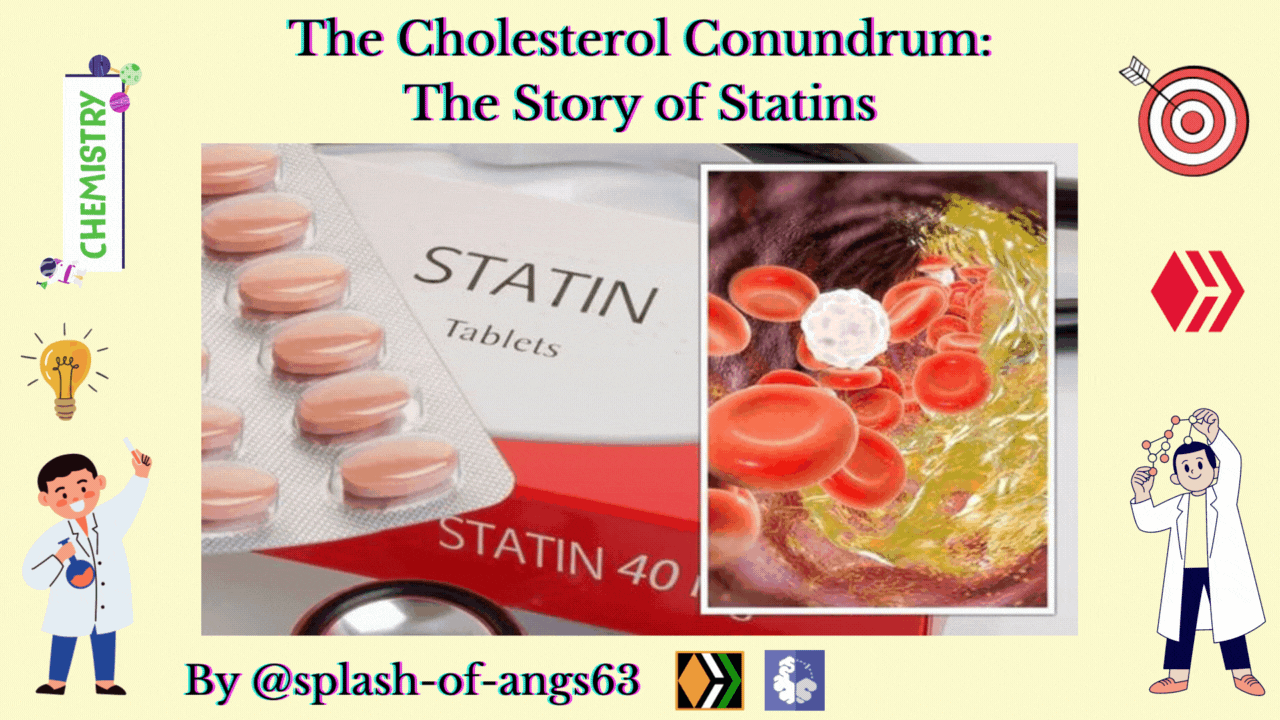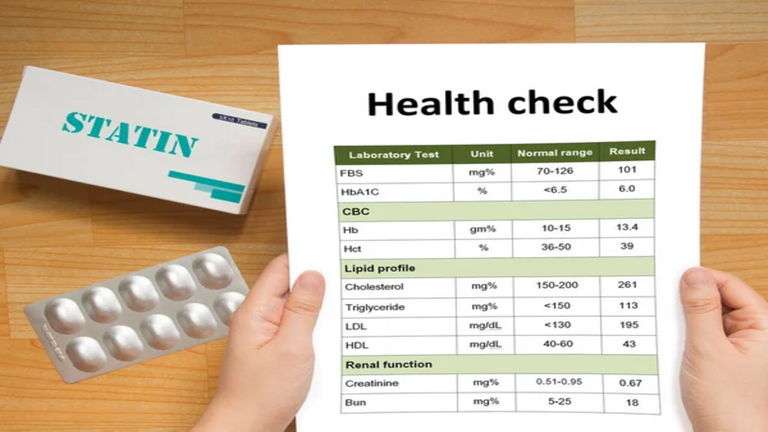The Cholesterol Conundrum: The Story of Statins |ChemFam #58|
Greetings to everyone! In the bustling rhythm of our modern lives, we often find ourselves in a relentless pursuit of health and well-being. From the kaleidoscope of diets promising longevity to the relentless quest for physical fitness, our daily routines are punctuated with choices that either elevate or compromise our health.

Imagine your typical morning. You groggily stumble to the kitchen, bleary-eyed, yearning for that steaming cup of coffee to jolt you into the day. Then there's the breakfast dilemma – do you reach for that sugary cereal, or do you opt for a hearty bowl of oatmeal? These seemingly mundane choices, repeated day after day, can shape your health in profound ways. Amid this journey, one term looms large on the landscape of contemporary health discussions: statins.
Statins are an important group of cholesterol lowering drugs that act as enzyme inhibitors. Statins, like a silent partner in our quest for health, work tirelessly behind the scenes to keep our hearts humming along smoothly. They are the safety net for those moments when the allure of fast food trumps our better judgment or when the couch beckons louder than the gym.

Statins inhibit the key step in cholesterol production where 3-hydroxy-3-methylglutaryl-CoA (HMGC) is converted to mevalonate by HMGC reductase. In doing so, they have lipid-lowering effects that reduce cardiovascular risk and mortality.
Statins or HMG-CoA reductase inhibitors appeared in the 20th century. Historically, they have been used to lower high cholesterol, reduce the risk of heart disease and ultimately save lives. They are rapidly gaining popularity for their ability to lower LDL (low-density lipoprotein) cholesterol, commonly known as "bad" cholesterol.
Cholesterol and Coronary Heart Disease
Cholesterol is an important constituent of cell membrane and is also biosynthetic precursors for steroid hormones. Problems arise if too much cholesterol is present in the diet as this can lead to cardiovascular disease.

Cholesterol is a fatty molecule and so it can not dissolve in blood and has to be transported round the body by particles known as low-density lipoproteins (LDL) or high-density lipoproteins (HDL). Mortality associated with coronary heart disease are associated with high levels of LDL or low levels of HDL. LDL's transport cholesterol to the arteries and if cholesterol is retained there, it can lead to the formation of fatty plaques which narrow the arteries, resulting in an increased risk of atherosclerosis. Thus, lowering the levels of LDL and or increasing the levels of HDL could potentially reduce the risk of heart attacks and strokes. Statins were designed initially with the aim to reduce or lower the levels of cholesterol that were synthesized in the body.

The Target Enzyme
Cholesterol is produced in cells, and one way to lower cholesterol in the blood is to block this synthesis. This can be done by finding a drug that inhibits an enzyme involved in cholesterol biosynthesis. However, the biosynthetic pathway contains more than 30 enzymes, so how do you decide which of these enzymes is the best target? The selection can be narrowed down by targeting the enzymes that cause the limiting step of the whole process as this provides the best inhibition of the biosynthetic pathway. The enzyme that catalyzes the rate-limiting step is a reductase enzyme called 3-hydroxy-3-methylglutaryl-CoA reductase (HMGR or HMG-CoA reductase). The related reaction is the conversion of 3-hydroxy-3-methylglutaryl coenzyme A (HMG-CoA) to mevalonate with the help of NADPH as a cofactor.

HMGR consists of four protein subunits and is one of the most ordered enzymes known. If the cholesterol is too much, the activity of this enzyme can be reduced in many ways. First, the high cholesterol level in the cell activates a signal transduction mechanism that activates protein kinase that phosphorylates and inactivates HMGR. Secondly, the rate at which these synthetases are taken up and translated is controlled by cholesterol levels in the body. Finally, the rate of enzymatic degradation appears to be affected by cholesterol.


The Discovery of Statins
When the HMGR enzyme was identified as a potential target, scientists began looking for a lead compound that would block it. They first focused on compounds produced by microbes. This may sound strange, but this is because microbes are constantly at war with each other, so the microbe that produces the poison for another microbe will benefit well when there is no struggle to survive. Bacteria lacking HMGR appear to be able to produce HMGR inhibitors that are toxic to bacteria that need HMGR to produce essential sterols.
Compactin (Mevastatin) is the first potent statin discovered to inhibit HMGR. It is a natural product isolated from Penicillium citrus in the 1970s.
In 1978, Merck isolated a similar compound called mevinolin from the fermentation broth of Aspergillus terreus. It is also a potent inhibitor, and clinical trials began in 1980. Launched as lovastatin in 1987, the drug has revolutionized the treatment of hypercholesterolemia (high cholesterol).
Simvastatin, a semi-synthetic preparation from lovastatin, was first approved in 1988. Pravastatin is derived from compatin by biotransformation and was produced in 1991.

These statins represent first generation statins and are classified as type I statins. All are directly or indirectly derived from fungi and have a similar structure, including a polar "head group" and a hydrophobic moiety containing a bicyclic decahydronaphthalene ring.

Mechanism of Action of Statins- Pharmacodynamics
Statins work by acting as competitive inhibitors, performing natural processes and competing with them for binding to the active site. Unlike natural substrates, they do not have enzymatic reactions and bind more strongly. How do we explain all this?
Both the polar main group and the hydrophobic moiety are important for the action of statins. All statins share the same head chain, which acts as a natural substrate (HMG-SCoA).Thus, the leading group of statins can act as a natural substrate and bind to the active site using the same interaction. We now need to explain why statins bind more strongly than their natural substrates and why they are resistant to enzyme-catalyzed reactions!
Firstly, statins have additional hydrophobic sites that can form additional hydrophobic interactions with hydrophobic binding sites found in enzymes. This results in stronger binding of the statin.
Secondly, statins are resistant to enzyme-catalyzed reactions because the coenzyme A moiety in the substrate (acts as leaving group) is replaced by a hydrophobic group that does not activate a group.


The Controversy
Despite their widespread use and success, statins are not without controversy. Critics say the side effects of the drugs can be serious and their benefits are exaggerated. Side effects include muscle pain, weakness, and an increased risk of diabetes. Some publications even link statin use to memory problems and cognitive impairment.
It is especially important to address concerns about muscular side effects.
Sometimes changing the type or dose of statin can reduce these problems. It is important for patients to report side effects to their doctor promptly so that their treatment can be adjusted.
While statins play a vital role in cardiovascular health, they are not a panacea. Lifestyle factors, such as diet, exercise, and smoking cessation, remain crucial in reducing the risk of heart disease. Combining medication with a heart-healthy lifestyle can provide the most substantial benefits.

Conclusive thoughts
The story of statins comes with both controversy and clarity. These drugs can save lives and reduce the burden of heart disease, but they are not without their challenges. A balanced approach to their use is essential, with careful consideration of individual risk factors and side effects.

Ultimately, deciding to take a statin should be an informed decision in collaboration with your doctor. As our understanding of these drugs continues, new insights will emerge that help improve their role in the prevention and treatment of heart disease. Until then, the key will be to increase their effectiveness while minimizing their potential decline to ensure that statins continue to play an important role in controlling the heart health of millions of people around the world.
Until we meet again :)
An Introduction to Medicinal Chemistry, Graham L. Patrick
Unveiling The Control Of Chemistry: How Hormones Dictate Our Mood |ChemFam #57|
Thermodynamic Versus Kinetic Control of Reactions |ChemFam #56|
Bosons: The Quantum Glue That Holds The Universe Together |ChemFam #55|
Extraction of Lithium Using Electrode Materials of Lithium Ion Battery-II |ChemFam #54|
Extraction of Lithium Using Electrode Materials of Lithium Ion Battery |ChemFam #53|
Helium: The First Noble Gas |ChemFam #52|
Hydrogen: The Simplest Atom |ChemFam #51|
Elements, Atoms and Atomic Theory |ChemFam #50|
Have You Thanked A Clod Today? |ChemFam #49|
Nuclear Energy: Will It Rise Again? |ChemFam #48|
Soaps: An Essential and Effective Cleansing Agent |ChemFam #47|
Chemicals in Food : Debunking Myths and Ensuring Safe Consumptions |ChemFam #46|
Unveiling The Secrets of Antiseptics and Disinfectants |ChemFam #45|
What are Antimicrobials and Antimicrobial Drugs? |ChemFam #44|
Therapeutic Action of Different Classes of Drugs |ChemFam #43|
Introduction to Drugs and Drug-Target Interaction |ChemFam #42|
Scientists Analyze a Single Atom With X-Rays For The First Time |ChemFam #41|
PS The thumbnail image is being created by me using canva.com by using template image from Asiana Times


Congratulations!
Your post has been manually curated and reblogged.
You can follow our curation trail on Hive.Vote
If you want to support us and the authors we vote for you can upvote this comment or delegate some Hive Power to our account. Thanks!
Propose a worthy post by mentioning us in the post or in a comment.
We reblog curated posts, follow us if you wish to see them in your feed.
Some people have the routine to starve themselves all for what? Losing weight.
This post has been manually curated by @bhattg from Indiaunited community. Join us on our Discord Server.
Do you know that you can earn a passive income by delegating to @indiaunited. We share more than 100 % of the curation rewards with the delegators in the form of IUC tokens. HP delegators and IUC token holders also get upto 20% additional vote weight.
Here are some handy links for delegations: 100HP, 250HP, 500HP, 1000HP.
100% of the rewards from this comment goes to the curator for their manual curation efforts. Please encourage the curator @bhattg by upvoting this comment and support the community by voting the posts made by @indiaunited.
Thanks for your contribution to the STEMsocial community. Feel free to join us on discord to get to know the rest of us!
Please consider delegating to the @stemsocial account (85% of the curation rewards are returned).
Thanks for including @stemsocial as a beneficiary, which gives you stronger support.